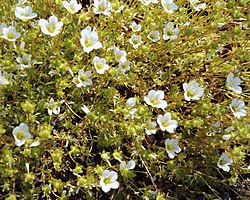| Saxifraga hypnoides | |
|---|---|
 | |
| At the Botanical Garden of the University of Fribourg | |
 | |
| Close-up of flower | |
| Scientific classification | |
| Kingdom: | Plantae |
| Clade: | Tracheophytes |
| Clade: | Angiosperms |
| Clade: | Eudicots |
| Order: | Saxifragales |
| Family: | Saxifragaceae |
| Genus: | Saxifraga |
| Species: | S. hypnoides |
| Binomial name | |
| Saxifraga hypnoides | |
| Synonyms [1] | |
List
| |
Saxifraga hypnoides, called mossy saxifrage, cut-leaved saxifrage, Dovedale moss, Eve's cushion, Indian moss, lady's cushion, and queen's cushion, is a species of flowering plant in the family Saxifragaceae. [2] It is native to northwestern Europe; Iceland, the Faroe Islands, Norway, Ireland, Great Britain, Belgium, and France, and has been introduced to Czechia, the Eastern Himalayas, and Tibet. [1] In the north of its range a tetraploid form predominates, and in the south a diploid form is more likely to be found. [3]
For forms in gardens (red, pinkish or white flowered) see Saxifraga × arendsii.